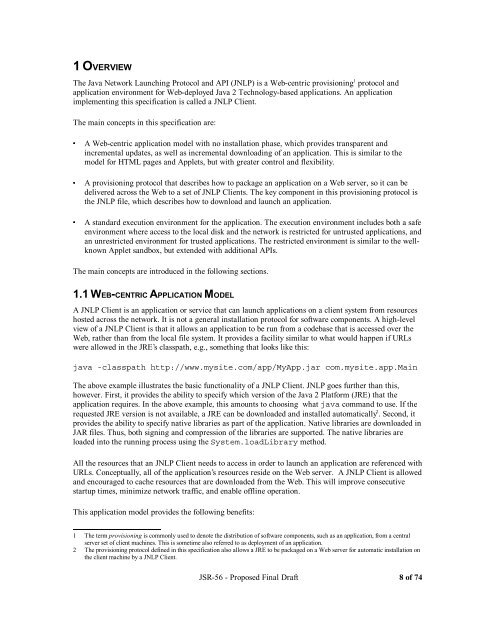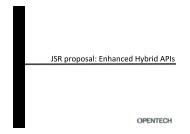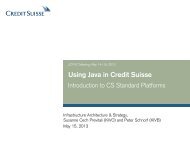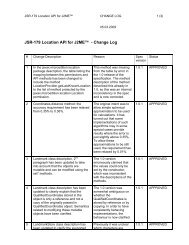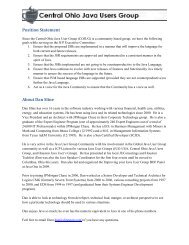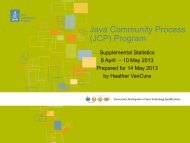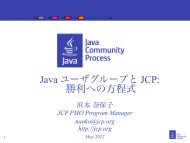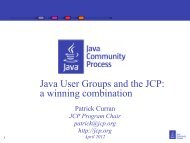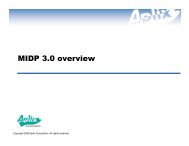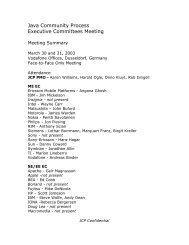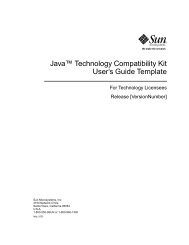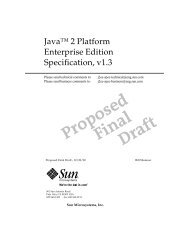jsr-56 - Java Community Process Program
jsr-56 - Java Community Process Program
jsr-56 - Java Community Process Program
Create successful ePaper yourself
Turn your PDF publications into a flip-book with our unique Google optimized e-Paper software.
1 OVERVIEW<br />
The <strong>Java</strong> Network Launching Protocol and API (JNLP) is a Web-centric provisioning 1 protocol and<br />
application environment for Web-deployed <strong>Java</strong> 2 Technology-based applications. An application<br />
implementing this specification is called a JNLP Client.<br />
The main concepts in this specification are:<br />
A Web-centric application model with no installation phase, which provides transparent and<br />
incremental updates, as well as incremental downloading of an application. This is similar to the<br />
model for HTML pages and Applets, but with greater control and flexibility.<br />
A provisioning protocol that describes how to package an application on a Web server, so it can be<br />
delivered across the Web to a set of JNLP Clients. The key component in this provisioning protocol is<br />
the JNLP file, which describes how to download and launch an application.<br />
A standard execution environment for the application. The execution environment includes both a safe<br />
environment where access to the local disk and the network is restricted for untrusted applications, and<br />
an unrestricted environment for trusted applications. The restricted environment is similar to the wellknown<br />
Applet sandbox, but extended with additional APIs.<br />
The main concepts are introduced in the following sections.<br />
1.1 WEB-CENTRIC APPLICATION MODEL<br />
A JNLP Client is an application or service that can launch applications on a client system from resources<br />
hosted across the network. It is not a general installation protocol for software components. A high-level<br />
view of a JNLP Client is that it allows an application to be run from a codebase that is accessed over the<br />
Web, rather than from the local file system. It provides a facility similar to what would happen if URLs<br />
were allowed in the JRE’s classpath, e.g., something that looks like this:<br />
java -classpath http://www.mysite.com/app/MyApp.jar com.mysite.app.Main<br />
The above example illustrates the basic functionality of a JNLP Client. JNLP goes further than this,<br />
however. First, it provides the ability to specify which version of the <strong>Java</strong> 2 Platform (JRE) that the<br />
application requires. In the above example, this amounts to choosing what java command to use. If the<br />
requested JRE version is not available, a JRE can be downloaded and installed automatically 2 . Second, it<br />
provides the ability to specify native libraries as part of the application. Native libraries are downloaded in<br />
JAR files. Thus, both signing and compression of the libraries are supported. The native libraries are<br />
loaded into the running process using the System.loadLibrary method.<br />
All the resources that an JNLP Client needs to access in order to launch an application are referenced with<br />
URLs. Conceptually, all of the application’s resources reside on the Web server. A JNLP Client is allowed<br />
and encouraged to cache resources that are downloaded from the Web. This will improve consecutive<br />
startup times, minimize network traffic, and enable offline operation.<br />
This application model provides the following benefits:<br />
1 The term provisioning is commonly used to denote the distribution of software components, such as an application, from a central<br />
server set of client machines. This is sometime also referred to as deployment of an application.<br />
2 The provisioning protocol defined in this specification also allows a JRE to be packaged on a Web server for automatic installation on<br />
the client machine by a JNLP Client.<br />
JSR-<strong>56</strong> - Proposed Final Draft 8 of 74


